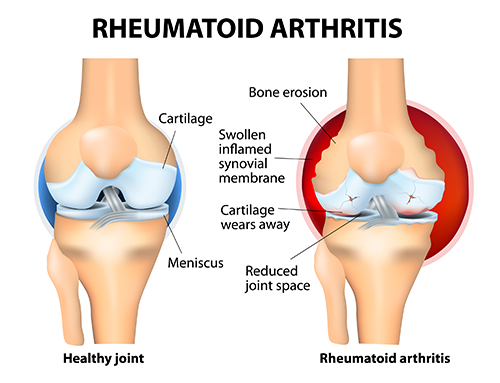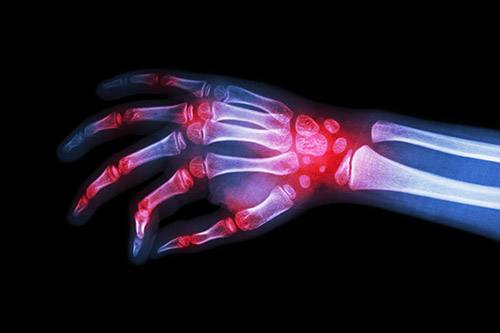Best Supports for Rheumatoid Arthritis
Anyone who suffers from rheumatoid arthritis doesn't need to be reminded how irritating and debilitating it can be. The condition can cause joints to swell up and become sensitive or even painful after time, turning what were once simple actions like writing, typing or picking up objects into difficult and even stressful ordeals. There is hope though, as it doesn't have to be this way. We at Health and Care have created a guide to help you better understand rheumatoid arthritis, along with its causes and symptoms, and we've compiled a list of products we think will help you along your road to recovery.
What is Rheumatoid Arthritis?
The first step to combating any ailment is to understand what it is, and where it comes from. Rheumatoid arthritis is an autoimmune disease that causes inflammation and swelling in your joints. This sets it apart from osteoarthritis, which is caused by ageing and the gradual wear and tear of the joints. Rheumatoid arthritis occurs when the synovium (a structure that keeps your joints lubricated so they can move without friction and pain) becomes inflamed, causing redness, swelling and pain. When the inflammation goes down, the synovium can no longer hold your joint in the proper position, causing it to become unstable and allowing your joint to move into unusual positions. After repeated inflammations of this kind, the joint begins to wear away, making the arthritic symptoms worse and worse.

What Causes Rheumatoid Arthritis?
After learning about what this condition is, many of you are probably wondering what you can do to prevent it. With roughly 400,000 cases in the UK, rheumatoid arthritis is a fairly common condition, mostly affecting women and those over the age of 40. That's not to say we all shouldn't be careful, as this affliction can affect pretty much anyone. While we don't know exactly what the catalyst for the inflammation that sets off rheumatoid arthritis is, we know of several factors that may boost your chances of developing the condition. Among the most common causes are:
- Smoking
- Eating large amounts of red meat
- Drinking coffee and caffeine
These factors have been known to boost risk of arthritic development, though there are a wide range of other risk factors. The most prevalent of these is genetic disposition, but again, this alone will not guarantee arthritis risk.
It's not all doom and gloom though, as there has been research suggesting a number of ways we can combat our arthritic risk. Rheumatoid arthritis has been found to be less common in those:
- With a high intake of vitamin C
- Who drink alcohol in moderation
How Can I Tell If I Have Rheumatoid Arthritis?
Symptoms of rheumatoid arthritis tend to show themselves sporadically, coming and going in rotation over time. Varying from person to person, these symptoms will usually begin in a restrained manner, showing themselves in a finger, a wrist or the balls of the feet intermittently. Common symptoms can include:
- Joint pain and swelling
- Stiffness
- Fatigue, irritability
- Anaemia
- Flu-like symptoms
- Rapid loss of joint function
Those who suffer from rheumatoid arthritis will also often report feeling stiff in the morning, and gradually loosening up over the day. If you commonly experience these symptoms for periods that last over half an hour, we recommend that you consult your physician. Research shows that the sooner you identify and start your treatment, the more effective it's likely to be.
No single tests have been found to provide a definite diagnosis of rheumatoid arthritis in its early stages. This means that patients must work together with physicians to provide a list of contributing symptoms and test results in order to discover the condition while it is still easy to treat. The best detection method involves a cataloguing of symptoms, along with physical examinations, x-rays, scans and blood tests.

How We Can Help
Now that we've given you an overview of rheumatoid arthritis and what it means for you, it's time for us to earn our keep. We've compiled a short list of braces and supports that can help you fight back against your arthritis, letting you carry on with your day, pain-free. Whether your symptoms are in your wrist, knee or ankle, we have the products and expertise to take your pain, stiffness and swelling off both your joints and your mind. Together with professional treatment and good habits, these supports will set you on your way to pain-free joints.
Bauerfeind GenuTrain Knee Brace
This knee brace is the ultimate in protection for swollen, painful knees that are afflicted by rheumatoid arthritis. If you've found that your ability to stay active and keep moving has been affected by your arthritis, this is the knee brace for you. Working to stabilise your knee and offload pressure, this brace supports the joint to reduce pain and further ligament damage.
Made with a skin-friendly "Train Active" knitted fabric, the brace includes an integral massage pad to help reduce pain and bring down arthritis-related swelling. To enhance comfort, the back of this brace is made with a soft material and ensures a snug fit so it will stay in place to support you where you need it most. Breathable and lightweight, this aware-winning brace will provide you with relief from your symptoms in a package that you can wear pretty much anywhere.
Bauerfeind ManuTrain Wrist Support
If you're looking for a wrist support to provide you with relief from swelling and pain, this just may be the perfect rheumatoid arthritis aid for you. This comfortable and protective support is especially suitable for the active user, making gripping and fine motor movements pain-free and simple. It works by taking the strain off of your wrist joints, nerves and blood vessels, reducing irritation, pain and swelling.
Stabilising and massaging the area, this anatomically shaped support will sit comfortably on your hand without slipping, all the while working to boost circulation and help with your recovery. Two pads remove pressure from the nerves and blood vessels, while the skin-friendly knitted fabric adapts to your every action to move where you do. At the edge of the padding, the ManuTrain features softer, elastic materials, allowing you a full range of motion and full mobility for your hand.
Have any questions, or anything to add? Tell us in the comments below, or find us on Facebook and Twitter!
